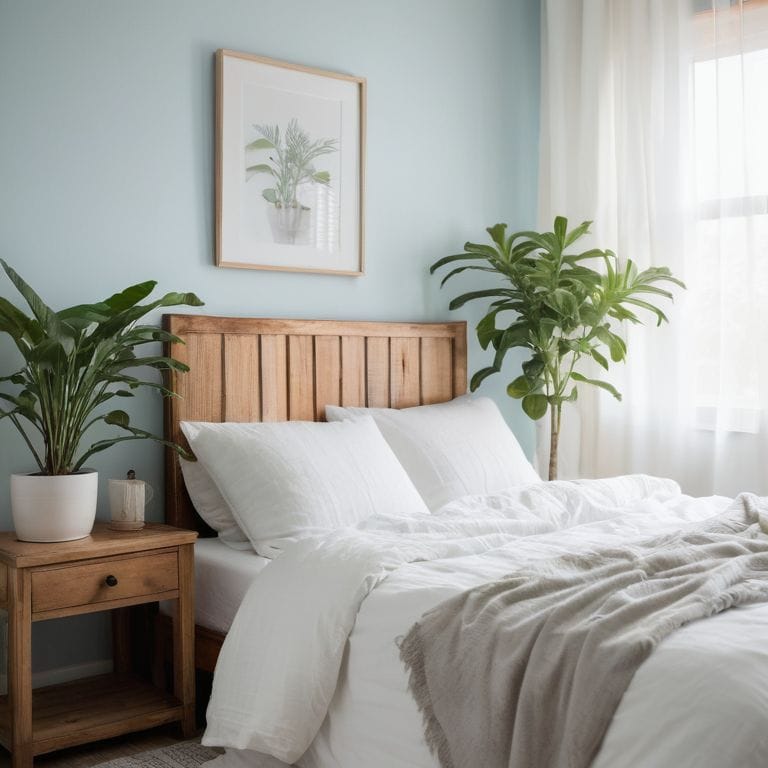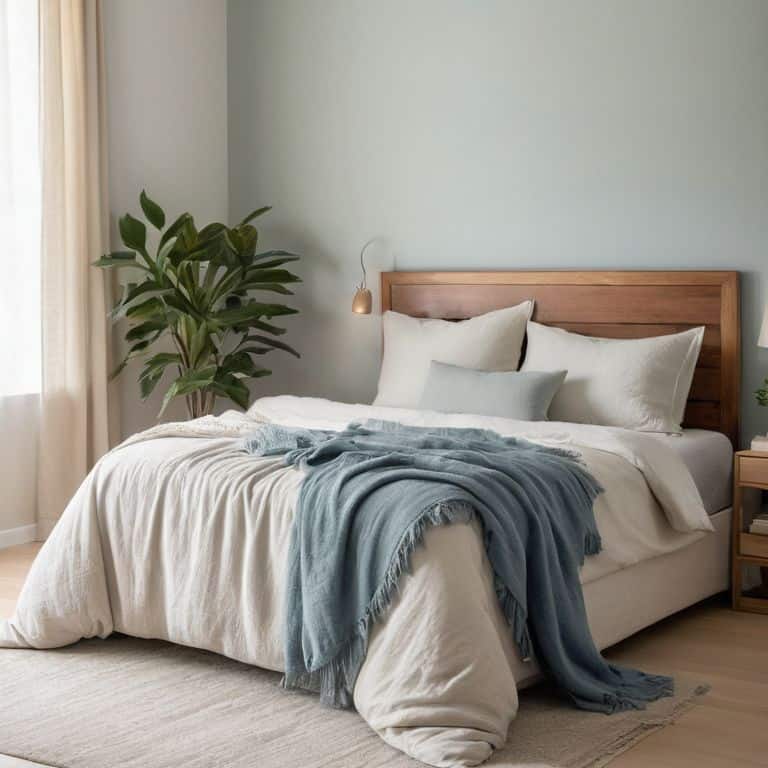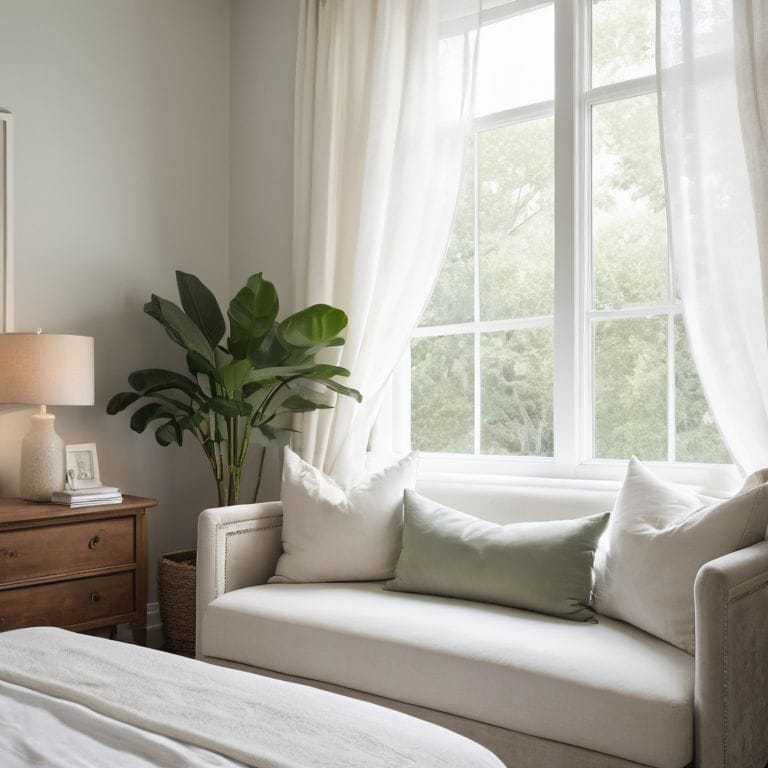As I sit here in my own serene sanctuary, I often think about the common myth that creating a relaxing bedroom is all about lavish decor and expensive furniture. But the truth is, learning how to create a relaxing bedroom has very little to do with material possessions and everything to do with intention and simplicity. I’ve seen it time and time again in my work as a professional organizer: a cluttered bedroom is often a reflection of a cluttered mind. By stripping away the unnecessary and focusing on what truly brings us peace, we can transform our bedrooms into oases of calm.
In this article, I’ll share my practical, no-nonsense advice on how to create a relaxing bedroom that truly feels like a retreat from the world. We’ll explore the psychological principles behind why certain design choices and organizing strategies can either soothe or stress the mind. I’ll guide you through a step-by-step process to let go of clutter, create a calming atmosphere, and design a space that nurtures your mind and body. By the end of this journey, you’ll have the tools and inspiration to turn your bedroom into a true sanctuary, a place where you can rest, recharge, and wake up feeling refreshed and renewed.
Table of Contents
Guide Overview: What You'll Need

Total Time: 2 hours 30 minutes
Estimated Cost: $100 – $200
Difficulty Level: Intermediate
Tools Required
- Paint Roller (with extension pole)
- Paintbrush (various sizes)
- Measuring Tape
- Level
- Screwdriver (for assembling furniture)
- Drill (for hanging items on walls)
- Pencil (for marking walls)
- Ruler (for drawing straight lines)
- Utility Knife (with extra blades)
Supplies & Materials
- Softer Color Paint (for calming atmosphere)
- Comfortable Bedding ( sheets, blankets, comforter)
- Blackout Curtains (for better sleep)
- Peaceful Artwork (to create a calming ambiance)
- Plants (for air purification and aesthetics)
- Aromatherapy Essentials (essential oils, diffuser)
- Soft Lighting (table lamps, floor lamps)
- Sound Machine (for white noise or nature sounds)
- 2 inches Thick Mattress Topper (for extra comfort)
Step-by-Step Instructions
- 1. To start creating your relaxing bedroom sanctuary, begin by clearing the space. This means taking everything out of your bedroom, yes, everything. It’s essential to start with a blank slate to truly understand what you have and what you need. As you remove items, sort them into categories like clothes, books, and miscellaneous items. This will help you see what you have and make decisions about what to keep, donate, or discard.
- 2. Next, assess your bedroom’s layout. Consider the natural light, the position of doors and windows, and the flow of traffic. Think about how you want to use your bedroom – is it just for sleeping, or do you want a reading nook or a workspace? Understanding the layout and your needs will help you create a functional and peaceful space.
- 3. Now, it’s time to set intentions for your bedroom. What do you want to feel when you’re in your bedroom? Do you want to feel calm, relaxed, or inspired? Write down your intentions and keep them somewhere visible to remind yourself what you’re working towards. This will help guide your decisions as you put your bedroom back together.
- 4. With your intentions in mind, start thinking about the furniture and decor you want to keep or add. Consider the style and aesthetic you’re aiming for – do you like modern and sleek, or cozy and traditional? Make sure each piece of furniture or decor serves a purpose or brings you joy. Remember, every object in your bedroom should have a purpose or a place.
- 5. Once you have a sense of the furniture and decor you want, it’s time to create a color palette. Choose colors that promote relaxation and calmness, such as soft blues, pale greens, or neutral tones. Consider the 60-30-10 rule: 60% of the room is a dominant color, 30% is a secondary color, and 10% is an accent color. This will help create a sense of balance and harmony in your bedroom.
- 6. Lighting is also crucial in creating a relaxing atmosphere. Layer your lighting to include overhead lighting, table lamps, and string lights. This will allow you to adjust the lighting to suit your mood and activities. Consider using smart bulbs or dimmers to make it easy to change the lighting levels.
- 7. As you put your bedroom back together, pay attention to texture and sound. Add plants, rugs, and throw blankets to create a cozy and inviting atmosphere. Consider using a white noise machine or a fan to block out any outside noise and create a sense of calm. Remember, your bedroom should be a sanctuary that soothes your soul.
- 8. Finally, make your bedroom a technology-free zone. Remove the TV, computer, and any other screens to create a space that promotes relaxation and sleep. Use this space to unwind and recharge, and avoid using it as a workspace or entertainment area. By doing so, you’ll be able to create a truly relaxing bedroom that helps you feel calm and refreshed.
Creating Serene Spaces

As we delve into the world of serene spaces, it’s essential to consider the impact of calming bedroom wall colors on our minds. Soft hues such as light blue or pale green can create a sense of tranquility, making it easier to unwind after a long day. I’ve seen this firsthand in my own home, where a gentle shade of blue has transformed my bedroom into a peaceful retreat.
In addition to color, bedroom lighting for better sleep plays a crucial role in setting the tone for a restful night’s sleep. Table lamps or floor lamps with soft shades can create a warm, inviting ambiance, while also providing sufficient light for reading or relaxation. By striking the right balance between light and darkness, we can create an environment that nurtures our minds and bodies.
To take your serene space to the next level, consider the importance of air purification in bedrooms. By removing allergens and pollutants from the air, you can breathe easier and sleep more soundly. This, combined with a clutter-free space, can have a profound impact on your overall well-being, allowing you to wake up feeling refreshed and revitalized.
Calming Colors for the Soul
When it comes to calming colors, I always think about the gentle hues of nature. Soft blues, like a clear sky on a summer day, and pale greens, reminiscent of a forest canopy, have a profound impact on our psyche. These colors can slow down our heart rate and quiet our minds. I’ve seen it time and time again in my work as a professional organizer – a room painted with soothing colors can be transformative. It’s not just about aesthetics; it’s about creating an atmosphere that nurtures our well-being.
In my own home, I’ve used a light beige on the walls, which provides a sense of warmth and coziness. This neutral background allows me to introduce pops of color through furniture and decor, keeping the space feeling calm and serene. By choosing colors that promote relaxation, we can set the tone for a restful and rejuvenating bedroom experience.
Clutter Free for Better Sleep
To truly create a serene space, it’s essential to tackle the often-overlooked culprit of poor sleep: clutter. I like to think of clutter as a physical manifestation of a cluttered mind. When our surroundings are chaotic, our brains have a hard time winding down. By removing unnecessary items and assigning a purpose or place to each belonging, we can begin to quiet the visual noise that keeps us awake at night.
I recommend starting with small steps, like clearing off your nightstand or sorting through that pile of clothes in the corner. As you work, ask yourself if each item brings you peace or serves a purpose. If not, consider letting it go. This mindful approach to decluttering can be incredibly therapeutic, and it’s amazing how quickly a clutter-free space can become a sleep sanctuary.
Sanctuary Essentials: 5 Key Tips to a Peaceful Bedroom
- Let natural light in, but invest in blackout curtains for a restful night’s sleep
- Incorporate calming scents like lavender or vanilla through essential oils or scented candles
- Choose furniture with clean lines and minimal clutter, like a simple bed frame and a dresser with closed storage
- Add plants with soft foliage, such as ferns or peace lilies, to bring in a touch of natural serenity
- Establish a ‘no screens’ rule for at least an hour before bedtime to promote relaxation and improve sleep quality
Key Takeaways for a Peaceful Retreat
By intentionally designing your bedroom as a serene space, you can significantly improve the quality of your sleep and overall well-being, as the calm environment helps to clear your mind and soothe your body
Choosing the right colors and maintaining a clutter-free environment are crucial steps in creating a bedroom sanctuary, as they directly impact your emotional state and ability to relax, allowing you to unwind and recharge
Remember, the goal of crafting a relaxing bedroom is not just about aesthetics, but about creating a space that nurtures your mental and physical health, providing a tranquil escape from the stresses of everyday life, and helping you wake up feeling refreshed and revitalized
Sanctuary of the Soul
As we craft our bedroom sanctuary, remember that every object, every color, and every texture is an opportunity to whisper peace to our minds, and that the true art of creating a relaxing bedroom lies not in the furniture, but in the intention behind each deliberate choice.
Nathan Reed
Bringing it all Together: Your Path to a Peaceful Retreat

As we’ve journeyed through the process of creating a relaxing bedroom, we’ve touched on several key elements: from calming colors that soothe the soul, to the importance of a clutter-free environment for better sleep. We’ve also explored the concept of serene spaces, and how they can be crafted to promote relaxation and tranquility. By implementing these simple yet effective strategies, you’ll be well on your way to transforming your bedroom into a true sanctuary. Remember, it’s all about creating a space that wraps you in comfort and peace, allowing you to recharge for the challenges of everyday life.
As you embark on this transformative journey, I encourage you to view it as an opportunity for self-care and personal growth. By taking the time to carefully consider each element of your bedroom, from the colors on the walls to the furniture and decor, you’re not just creating a relaxing space – you’re investing in your well-being. So, take a deep breath, let go of the clutter and chaos, and step into your newfound sanctuary. Allow the peaceful atmosphere to envelop you, and let the sense of calm and serenity that fills your space be a reflection of the peace that resides within.
Frequently Asked Questions
What are some ways to minimize noise in the bedroom for better sleep?
To minimize noise, I recommend using sound-absorbing materials like acoustic panels or thick curtains. Consider a white noise machine or a fan to create a soothing background hum, masking any external sounds. This will help create a peaceful ambiance, allowing you to sleep more soundly.
How can I choose the right furniture to create a calming atmosphere in my bedroom?
When choosing furniture, I recommend selecting pieces with clean lines, minimal ornamentation, and a calming color palette. Consider the function of each item, too – does it serve a purpose or bring you joy? For a serene bedroom, opt for a simple, low-profile bed frame and a dresser with ample storage to keep clutter at bay.
Are there any specific lighting techniques that can help create a relaxing ambiance in the bedroom?
I’m a big fan of layering lighting to create a relaxing ambiance. Table lamps, floor lamps, and string lights can all contribute to a soothing atmosphere. Consider using warm-toned bulbs and dimmers to adjust the light levels, allowing you to ease into a peaceful state. This layered approach helps signal to your mind that it’s time to unwind.
